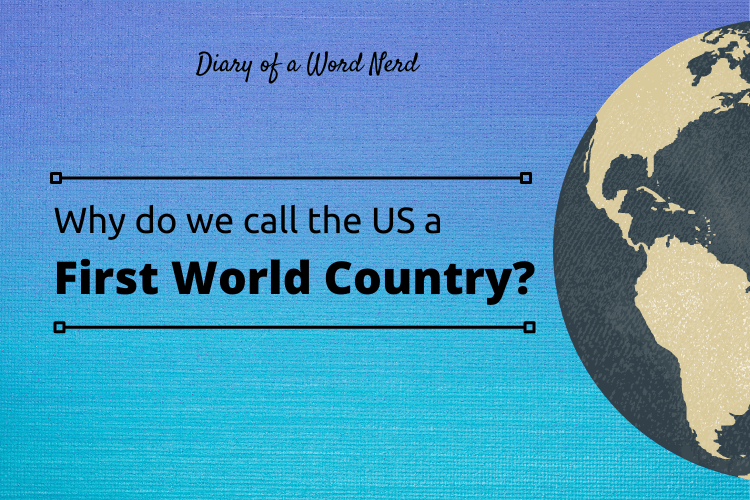During a summer evening discussion on the porch, my family pondered the status of vaccinations around the world. The term “First World Countries” came up, which prompted all of us to wonder, why do we call some countries “First World” and others “Third World”? And what about the “Second World” countries?
The “three worlds” model of geopolitics
Back in the 1950s, during the Cold War, French demographer Alfred Sauvy described the world in terms of three factions. In the article “Three Worlds, One Planet” which appeared in L’Observateur, Sauvy described “First World Countries” as the United States and its allies in The Cold War. That included most of Western Europe, Japan, and Australia. Second world countries were the Soviet Union, its Eastern European satellites, and other communist nations. Third World countries were those not allied with either side, including most of Africa, Asia, the Middle East, and Latin America. Those countries also frequently were former colonies of Europe and were poor.
As time went on, The Cold War alliances were forgotten, and “First World Countries” described wealthy, developed countries. The term “Third World Countries” characterized poor, developing nations. We don’t hear anyone talk about “Second World Countries” any more because the term died with the Soviet Union.
Problems with labeling countries
Since the terms “First World” and “Third World” started during The Cold War, many academics dismiss them as outdated. People studying or writing about poor nations use “developing countries” or “low and middle income countries” more often.
Some people like the “developing” descriptor. It suggests opportunity and potential for improvement. Others criticize the term for the underlying message of hierarchy. “Developed countries” suggests superiority, even though many “developed countries” have serious social issues, including pockets of severe poverty.
The World Health Organization categories countries based on statistics about Gross Domestic Product. This system classifies countries as low, middle, or high income. However, this label is problematic because its hard to get accurate data from all countries.
I found an interesting alternative to the 1-2-3 classification: Majority World. This term reminds us that the West is but a small fraction of the globe. I was shocked to learn that about 80% of the world lives on less than $10 a day. Yikes. I live in the global minority indeed.
Once again, we have an example of why labels fall short in describing the complexity of a situation or group of people. The articles I read suggested if you are talking about a country or group of countries, just use their names to describe them. Sounds like good advice to me, for lots of situations.
If you’d like to learn more about the three worlds model, check out these articles:
- “If you shouldn’t call it the Third World, what should you call it?” from NPR
- “Why are countries classified as First, Second, or Third World” from History.com
Thanks for getting nerdy with me!





Interesting info. I was unaware of the origin of those terms.
In 2018 and 2019, I went on mission trips to India and Kenya respectively. I was talking about the modern idea of 1st and 3rd world countries and said that one never hears of 2nd world countries. I knew that Kenya was not considered a 1st world country but neither was it a 3rd world country. I asked if anyone knew what such a country was called. Someone said, “I think they refer to such countries as an emerging economy.”
Those two mission trip are the only two truly international trips I have made . . . one can hardly count trips to Canada and a cruise that included a stop in the BVI to be “international travel.”
I wish that all Americans could do some international travel, and I do not mean “tourist” travel. It would be eye-opening to many Americans to learn how most of the world lives, even in more modern foreign nations such as Kenya and India. Many of the things we count to be very nearly necessities are just not available.
Even though the caste system is supposed to be illegal in India, it persists in informal ways. As we travelled between the cities, we would go through “the villages” (as they are called) and it was sad to see how they had to live. The people there would have been called “the untouchables” back in the caste system days. The villages were filthy with garbage lining the roads and pigs and dogs rooting through the garbage for food. The interesting thing I noticed is that the people living in the villages were dressed in clean Walmart-quality clothes and had brilliant white teeth and nicely done hair (the men, any way, for the women always have their heads covered, so I have no idea about their hair). Though their surroundings were appalling, they kept their persons (and I expect, the insides of their homes) in good conditions. And there were as many smiles in the villages as anywhere else. (An example of “money does not bring happiness.) But during Covid, these people were mostly forgotten. Though the government promised help, it never came. When the first round of Covid checks came in back in 2020, I felt I could not keep the money for I had no need of it. The man we worked with in India was doing all he could to help the folks in the villages. So I sent my Covid money to him (thankyou PayPal for allowing the transfer without charge!). The man was able to feed 200 FAMILIES for a week with the $1200.00 we sent him. It was so good to see the pictures of taking the food to the villages – the joy on the faces of the people was worth far more than $1200.00.
In the USA, I have often heard of complaints of “the 1%” who allegedly control so much of the wealth. But, every citizen in the USA needs to consider the fact that if we expand the demographic to include the entire world, we ARE the 1%. (Actually we make up about 4.5-5% of the world’s population).
I realize my comments run long so if you do not want to approve it for publication, that is fine. It’s just that I have no good editor in my brain! LOL. Thanks for your interesting post.